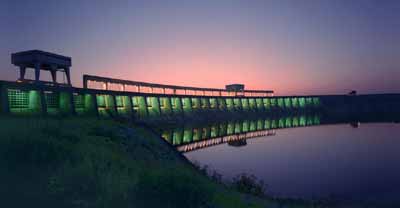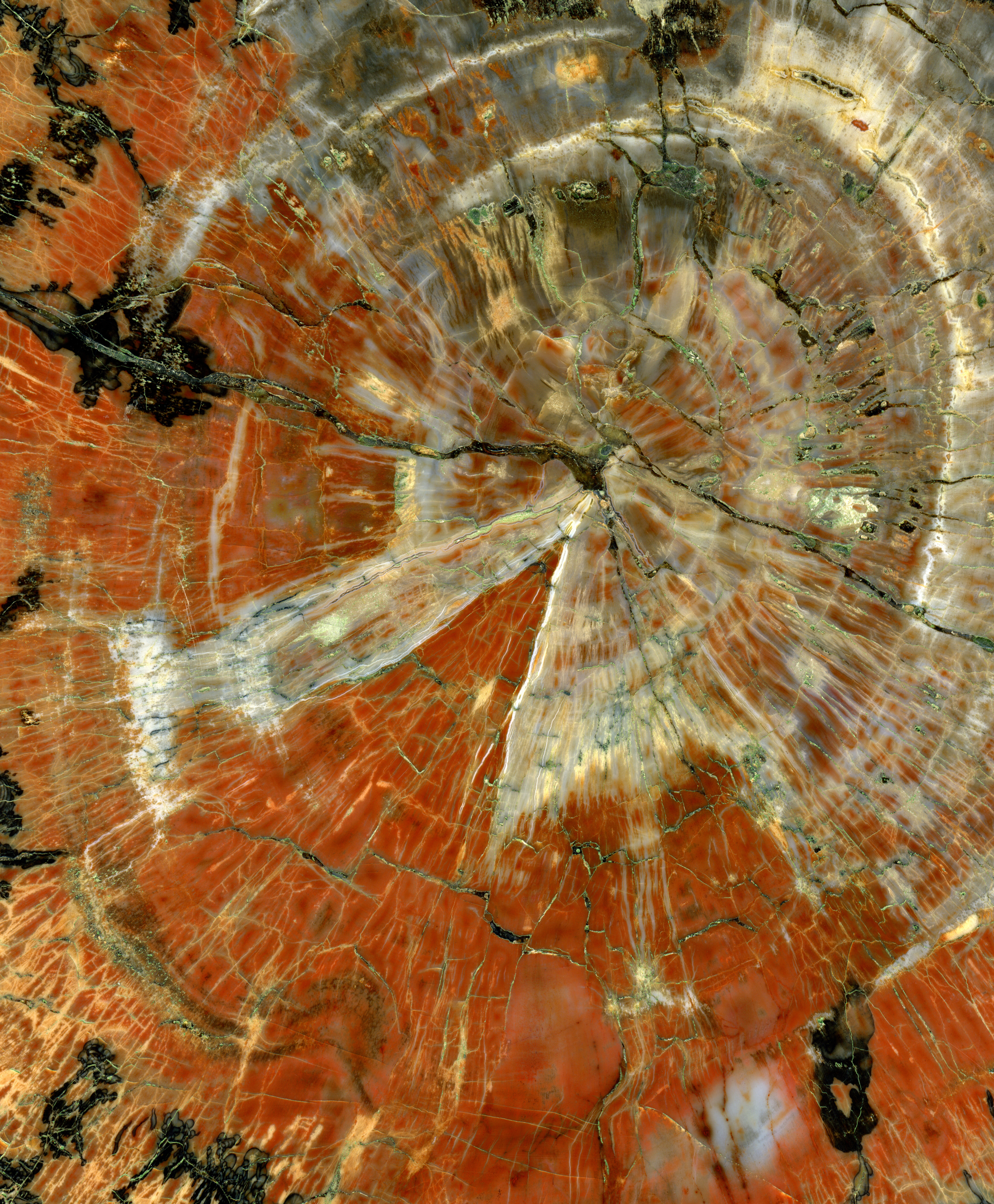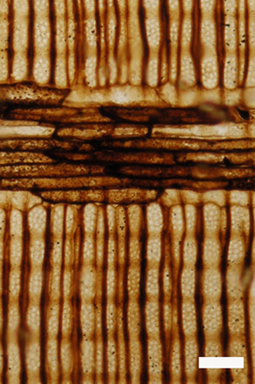|
Gilboa Fossil Forest
Gilboa Fossil Forest, New York, United States, is a petrified forest and one of the oldest known forests. Located near the Gilboa Dam in Schoharie County, New York, the region is home to tree trunks from the Devonian period. The fossils, some of the only survivors of their type in the world, are believed to have been from one of the first forests on Earth, and was part of the Earth's afforestation. Paleobotanists have been interested in the site since the 1920s when construction work for a water supply project found several large, vertical fossilized stumps. Some of these remain on display at the Gilboa Dam site () and the New York Power Authority Blenheim-Gilboa Visitor Center in Schoharie County and at the New York State Museum The New York State Museum is a research-backed institution in Albany, New York, Albany, New York (state), New York, United States. It is located on Madison Avenue, attached to the south side of the Empire State Plaza, facing onto the plaza and to .. ... [...More Info...] [...Related Items...] OR: [Wikipedia] [Google] [Baidu] |
Gilboa2
Gilboa may refer to: *Mount Gilboa, a biblical site in Israel, where King Saul's sons were killed by the Philistines, and Saul killed himself (1 Samuel 31:4) *Gilboa Regional Council *Two towns in the United States are named for the mountain: **Gilboa, New York **Gilboa, Ohio *Gilboa Fossil Forest, New York state, USA *The fictional kingdom of Gilboa, in the American TV series ''Kings Kings or King's may refer to: *Kings: The sovereign heads of states and/or nations. *One of several works known as the "Book of Kings": **The Books of Kings part of the Bible, divided into two parts **The ''Shahnameh'', an 11th-century epic Persia ...'' * Gilboa (surname) * Gilboa Prison in Israel {{disambiguation, geo ... [...More Info...] [...Related Items...] OR: [Wikipedia] [Google] [Baidu] |
New York Power Authority
The New York Power Authority (NYPA) is a public benefit corporation owned by the State of New York and is the largest state public power utility in the United States. It provides some of the lowest-cost electricity in the nation, operating 16 generating facilities and more than 1,400 circuit-miles of transmission lines. Its main administrative offices are in White Plains, New York. NYPA uses no state tax dollars and incurs no state debt, financing its projects principally through the sale of bond (finance), bonds. The bonds are repaid and the projects operated using revenues from operations. State and federal regulations determine NYPA’s customer base, which includes large and small businesses, not-for-profit organizations, public power systems and government agencies. NYPA also sells electricity to Private utility, private utilities for resale (without profit) to their customers, and to neighboring states, under federal requirements. Approximately 70 percent of the electricit ... [...More Info...] [...Related Items...] OR: [Wikipedia] [Google] [Baidu] |
Paleontology In New York (state)
Paleontology in New York refers to paleontological research occurring within or conducted by people from the U.S. state of New York. New York has a very rich fossil record, especially from the Devonian. However, a gap in this record spans most of the Mesozoic and early Cenozoic. Much of New York was covered in seawater during the early part of the Paleozoic era. This sea came to be inhabited by invertebrates like brachiopods, conodonts, eurypterids, jellyfish, and trilobites. Local marine vertebrates included arthrodires, chimaeroids, lobe-finned fishes, and lungfish. By the Devonian the state was home to some of the oldest known forests. The Carboniferous and Permian are missing from the local rock record. Little is known about Mesozoic New York, but during the early part of the era, carnivorous dinosaurs left behind footprints which later fossilized. The early to mid Cenozoic is also mostly absent from the local rock record. However, evidence indicates that during the Ice Ag ... [...More Info...] [...Related Items...] OR: [Wikipedia] [Google] [Baidu] |
Petrified Forests
Petrified wood (from Ancient Greek meaning 'rock' or 'stone'; literally 'wood turned into stone'), is the name given to a special type of '' fossilized wood'', the fossilized remains of terrestrial vegetation. ''Petrifaction'' is the result of a tree or tree-like plants having been replaced by stone via a mineralization process that often includes permineralization and replacement. The organic materials making up cell walls have been replicated with minerals (mostly silica in the form of opal, chalcedony, or quartz). In some instances, the original structure of the stem tissue may be partially retained. Unlike other plant fossils, which are typically impressions or compressions, petrified wood is a three-dimensional representation of the original organic material. The petrifaction process occurs underground, when wood becomes buried in water or volcanic ash. The presence of water reduces the availability of oxygen which inhibits aerobic decomposition by bacteria and fungi. M ... [...More Info...] [...Related Items...] OR: [Wikipedia] [Google] [Baidu] |
Protected Areas Of Schoharie County, New York
Protection is any measure taken to guard something against damage caused by outside forces. Protection can be provided to physical objects, including organisms, to systems, and to intangible things like civil and political rights. Although the mechanisms for providing protection vary widely, the basic meaning of the term remains the same. This is illustrated by an explanation found in a manual on electrical wiring: Some kind of protection is a characteristic of all life, as living things have evolved at least some protective mechanisms to counter damaging environmental phenomena, such as ultraviolet light. Biological membranes such as bark on trees and skin on animals offer protection from various threats, with skin playing a key role in protecting organisms against pathogens and excessive water loss. Additional structures like scales and hair offer further protection from the elements and from predators, with some animals having features such as spines or camouflage servi ... [...More Info...] [...Related Items...] OR: [Wikipedia] [Google] [Baidu] |
Forests Of New York (state)
A forest is an ecosystem characterized by a dense community of trees. Hundreds of definitions of forest are used throughout the world, incorporating factors such as tree density, tree height, land use, legal standing, and ecological function. The United Nations' Food and Agriculture Organization (FAO) defines a forest as, "Land spanning more than 0.5 hectares with trees higher than 5 meters and a canopy cover of more than 10 percent, or trees able to reach these thresholds ''in situ''. It does not include land that is predominantly under agricultural or urban use." Using this definition, '' Global Forest Resources Assessment 2020'' found that forests covered , or approximately 31 percent of the world's land area in 2020. Forests are the largest terrestrial ecosystems of Earth by area, and are found around the globe. 45 percent of forest land is in the tropical latitudes. The next largest share of forests are found in subarctic climates, followed by temperate, and subtropic ... [...More Info...] [...Related Items...] OR: [Wikipedia] [Google] [Baidu] |
Geology Of New York (state)
The geology of the State of New York is made up of ancient Precambrian crystalline basement rock, forming the Adirondack Mountains and the bedrock of much of the state. These rocks experienced numerous deformations during mountain building events and much of the region was flooded by shallow seas depositing thick sequences of sedimentary rock during the Paleozoic. Fewer rocks have deposited since the Mesozoic as several kilometers of rock have eroded into the continental shelf and Atlantic coastal plain, although volcanic and sedimentary rocks in the Newark Basin are a prominent fossil-bearing feature near New York City from the Mesozoic rifting of the supercontinent Pangea. Stratigraphy, Tectonics & Geologic History The igneous and metamorphic crystalline basement rock of New York formed in the Precambrian and are coterminous with the Canadian Shield. The Adirondack Mountains, Thousand Islands, Hudson Highlands, and Fordham gneiss, along with outcrops in the Berkshires just over ... [...More Info...] [...Related Items...] OR: [Wikipedia] [Google] [Baidu] |
Paleozoic Paleontological Sites Of North America
The Paleozoic ( , , ; or Palaeozoic) Era is the first of three geological eras of the Phanerozoic Eon. Beginning 538.8 million years ago (Ma), it succeeds the Neoproterozoic (the last era of the Proterozoic Eon) and ends 251.9 Ma at the start of the Mesozoic Era. The Paleozoic is subdivided into six geologic periods (from oldest to youngest), Cambrian, Ordovician, Silurian, Devonian, Carboniferous and Permian. Some geological timescales divide the Paleozoic informally into early and late sub-eras: the Early Paleozoic consisting of the Cambrian, Ordovician and Silurian; the Late Paleozoic consisting of the Devonian, Carboniferous and Permian. The name ''Paleozoic'' was first used by Adam Sedgwick (1785–1873) in 1838 to describe the Cambrian and Ordovician periods. It was redefined by John Phillips (1800–1874) in 1840 to cover the Cambrian to Permian periods. It is derived from the Greek ''palaiós'' (παλαιός, "old") and ''zōḗ'' (ζωή, "life") meaning "ancient lif ... [...More Info...] [...Related Items...] OR: [Wikipedia] [Google] [Baidu] |
New York State Museum
The New York State Museum is a research-backed institution in Albany, New York, Albany, New York (state), New York, United States. It is located on Madison Avenue, attached to the south side of the Empire State Plaza, facing onto the plaza and towards the New York State Capitol. The museum houses art, Artifact (archaeology), artifacts (prehistoric and historic), and ecofacts that reflect New York (state), New York’s cultural, natural, and geological development. Operated by the New York State Education Department's Office of Cultural Education, it is the oldest and largest state museum in the US. Formerly located in the New York State Department of Education Building, State Education Building, the museum now occupies the first four floors of the Cultural Education Center, a ten-story, building that also houses the New York State Archives and New York State Library. In 2020, the COVID-19 pandemic forced the NYSM, State Archives, and State Library to close temporarily, with museu ... [...More Info...] [...Related Items...] OR: [Wikipedia] [Google] [Baidu] |
Petrified Wood
Petrified wood (from Ancient Greek meaning 'rock' or 'stone'; literally 'wood turned into stone'), is the name given to a special type of ''fossilized wood'', the fossilized remains of terrestrial plant, terrestrial vegetation. ''Petrifaction'' is the result of a tree or tree-like plants having been replaced by stone via a mineralization process that often includes permineralization and replacement. The Carbon-based life, organic materials making up cell walls have been replicated with minerals (mostly silica in the form of opal, chalcedony, or quartz). In some instances, the original structure of the stem tissue may be partially retained. Unlike other plant fossils, which are typically impressions or compressions, petrified wood is a three-dimensional representation of the original organic material. The petrifaction process occurs underground, when wood becomes buried in water or volcanic ash. The presence of water reduces the availability of oxygen which inhibits aerobic dec ... [...More Info...] [...Related Items...] OR: [Wikipedia] [Google] [Baidu] |
New York (state)
New York, also called New York State, is a U.S. state, state in the northeastern United States. Bordered by New England to the east, Canada to the north, and Pennsylvania and New Jersey to the south, its territory extends into both the Atlantic Ocean and the Great Lakes. New York is the List of U.S. states and territories by population, fourth-most populous state in the United States, with nearly 20 million residents, and the List of U.S. states and territories by area, 27th-largest state by area, with a total area of . New York has Geography of New York (state), a varied geography. The southeastern part of the state, known as Downstate New York, Downstate, encompasses New York City, the List of U.S. cities by population, most populous city in the United States; Long Island, with approximately 40% of the state's population, the nation's most populous island; and the cities, suburbs, and wealthy enclaves of the lower Hudson Valley. These areas are the center of the expansive New ... [...More Info...] [...Related Items...] OR: [Wikipedia] [Google] [Baidu] |
Paleobotanists
Paleobotany or palaeobotany, also known as paleophytology, is the branch of botany dealing with the recovery and identification of plant fossils from geological contexts, and their use for the biological reconstruction of past environments (paleogeography), and the evolutionary history of plants, with a bearing upon the evolution of life in general. It is a component of paleontology and paleobiology. The prefix ''palaeo-'' or ''paleo-'' means "ancient, old", and is derived from the Greek adjective , . Paleobotany includes the study of land plants, as well as the study of prehistoric marine photoautotrophs such as photosynthetic algae, seaweeds or kelp. A closely related field is palynology, which is the study of fossilized and extant spores and pollen. Paleobotany is important in the reconstruction of ancient ecological and climate systems, known as paleoecology and paleoclimatology respectively. It is fundamental to the study of green plant development and evolution. Paleobot ... [...More Info...] [...Related Items...] OR: [Wikipedia] [Google] [Baidu] |







